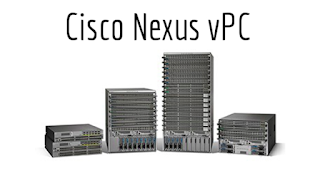Cisco Nexus vPC
When we
are going to deploy a new Data Center network, we always have to
think about the best network performance. If switches don’t have
high rate interfaces, such as 100 Gbps interfaces, we should use more
than one interface to get better performance. In addition, it’s a
good idea to design the Data Center network with more than one uplink
interface for redundancy because we’ll get better availability.
Therefore, as network engineers, we should always design networks
with several uplink interfaces for getting high performance and
availability.
The
best known technology for combining multiple network connections in
parallel in order to increase throughput beyond what a single
connection could sustain, and to provide redundancy in case one of
the links fail is the Link Aggregation
Control Protocol (LACP). However, there
are already proprietary aggregation schemes similar to LACP. For
example, the virtual
Port Channel (vPC) is a Cisco
technology which allow us to aggregate several port links
between different Cisco
Nexus switches to connect to a third party device (server, firewall,
load balancer, etc) that supports link
aggregation technology (LACP).
 |
| vPC Deployment Concept |
Link Aggregation, such as vPC, has lots of technical benefits. One of the
best technical benefit is the loop-free topology because it
eliminates Spanning
Tree Protocol (STP) blocked ports. In addition, we can use
all available uplink interfaces, thus all available bandwidth is
used, because we can send traffic for several interfaces at the same
time. Theses technical benefits also simplify the network design.
What’s more, Cisco vPC can be configured in different Cisco Nexus
switches, accordingly, there are independent control planes.
If we are
going to configure Cisco vPC, we’ll previously have to know the vPC
architecture components. For instance, each Cisco Nexus switch will
be a vPC Peer into the vPC domain. We also have to
configure the vPC Peer Link and the vPC Peer Keepalive Link
for the synchronization between vPC peer devices, which are
synchronized thanks to Cisco Fabric Services (CFS) over the
Ethernet protocol. In addition, there will be orphan ports for
orphan devices and vPC member ports for aggregated
switches.
 |
| vPC Architecture Components |
I would like to highlight the role of the vPC Peer Link and the vPC
Peer Keepalive Link. The vPC Peer Link is the most
important component, which gives us the illusion of a single control
plane, while the vPC Peer Keepalive Link is a Layer 3 backup
test used to verify both Peers are alive. Therefore, if vPC Peer
link fails and there is no Layer 3 communication, there will be a
split brain scenario and a network outage.
Finally, some of you, maybe, are thinking about the Virtual Switching
System (VSS) introduced by Cisco in Catalyst switches, or any
other Multi-Chassis
Link Aggregation technology built by other manufacturers, but
vPC is slightly different with regard to the control plane. Cisco
Nexus vPC maintains independent control planes.
 |
| Comparing Catalyst VSS with Nexus vPC |
If you are
interested in Cisco Nexus vPC and you need more information, you
should check The
Complete Cisco Nexus vPC Guide by Firewall.cx.
Do
you usually configure LACP in your Data Center?










Commentaires
Enregistrer un commentaire